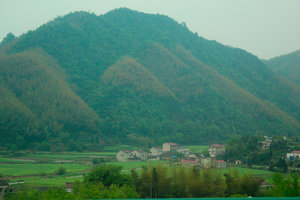Advertisement
Published: April 21st 2015


A mountain village in southern AnhuiHey it's Hannah. I split up with my two friends because their orphanage is further away, just the Montagues (mont-a-huez)(our friends in the adoption group with their daughter AiLi (pronounciation: I-lee) my friend) and us. It was a 4hour trip to the Yellow Mountain. In Chinese it's Huang Shan (hwong-shawn). BLEH!!!!!!!. I do NOT like long car/plane/bus/train/etc rides. We went to a market and bought stuff for my brothers it was really fun we also had some tea samples. I liked the oolong tea - yum. We bought some oolong tea to bring home. Write back tomorrow. -Hannah
-----------------
Today we split up our group - we drive 4 hours south of Anhui to Huangshan with one other family, while the other two families headed to Naning to visit different orphanages. Huangshan is a relatively small town of 200,000 people (they don't consider it a city unless the population is >1 million) with very little industry. The economy is predominately supported by tourism and agriculture. The region is very mountainous. Apparently this trip used to take ~ 8 hours, but was cut in half several years ago when they built a new highway with multiple tunnels through the mountains.


Pagoda in HuangshanThere are rice paddies everywhere and the mountainsides are covered with tea bushes on nearly vertical slopes - not sure how they manage not to slide down the hill as they are harvesting the tea leaves. This region is much more rural than the others we have been in. There are more than 1000 small villages that surround the town and still have traditional housing, and there are significantly fewer high-rise apartment buildings.
We walked along the Tunxi River this evening. The water is pretty cloudy but people continue to fish and wash their clothes in the river, as they have done for centuries. The town was once relatively prosperous as the rive allowed for trading of tea and bamboo. During the last dynasty (>150 yrs ago) the riverfront houses were transformed into a market place, which has been very well preserved and continues to be a center of activity for the city. The first floor of most of the houses have been updated and function as the store. The second and third floors are apparently unchanged form a century ago and function as the bedrooms and storage space. Some of the houses have elaborate wooden facades with large


A tea shop on the Old Street in Huangshanwooden lanterns hanging outside, similar to the buildings in the old section Chengdu. There are many shops, mostly selling tea, dried food stuff (spices, fungus, sauces, etc), wood and stone carvings, and classic Chinese artwork. We had a tea tasting in a 150 yr old tea house. The tea is locally grown, harvested within the past month, and has much better flavor than the teas we get in the states.
Had another great dinner of local fare tonight - smoked tofu, tofu and celery, radish soup, sweet and sore chicken, and deep fried whole fish (everyone ate at least one - head and all). The girls are learning a lot about Chinese culture, history, food, and language (the guides in each city teach then a few words each day) and will clearly return home with a much better understanding of the places they are from.
Advertisement
Tot: 0.116s; Tpl: 0.01s; cc: 8; qc: 55; dbt: 0.0488s; 1; m:domysql w:travelblog (10.17.0.13); sld: 1;
; mem: 1.1mb